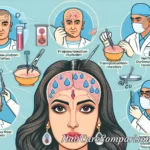After undergoing a hair transplant procedure, it is essential to follow specific guidelines to ensure the success of the treatment. One crucial aspect that patients need to consider is exercise restrictions post hair transplant. While physical activity is essential for overall health, engaging in certain exercises too soon after a hair transplant can have negative consequences on the newly implanted hair follicles. In this article, we will explore the exercise restrictions that patients should adhere to after a hair transplant to promote optimal results.
Understanding Hair Transplant
Before delving into exercise restrictions, it is essential to have a basic understanding of what a hair transplant entails. A hair transplant is a surgical procedure that involves taking hair follicles from one part of the scalp (donor area) and transplanting them to areas experiencing hair loss or thinning (recipient area). The goal of a hair transplant is to promote hair growth in areas where it has become sparse or non-existent, ultimately restoring a fuller and more natural-looking hairline.
Immediate Post-Transplant Period
Avoiding Strenuous Exercise
During the immediate post-transplant period, typically the first few days following the procedure, patients are advised to avoid any form of strenuous exercise. This includes activities such as running, weightlifting, cycling, or any other high-impact exercises that could increase blood pressure and heart rate. Elevating blood pressure and heart rate can lead to increased bleeding around the transplanted area, potentially dislodging the newly implanted grafts.
Limiting Physical Exertion
While it is essential to rest and allow the body to heal after a hair transplant, light activities such as walking are generally permissible. However, it is crucial to avoid excessive sweating, as sweat can irritate the scalp and potentially lead to complications. Patients should also refrain from bending over or engaging in activities that put strain on the scalp during this initial recovery period.
Transition Period
Gradual Resumption of Exercise
As the healing process progresses, typically within the first week or two after the hair transplant, patients may gradually resume light to moderate exercise. It is crucial to listen to your body and not push yourself beyond your limits. Activities such as brisk walking, gentle yoga, or light stretching can be beneficial during this transitional period.
Avoiding Direct Trauma
While it may be tempting to return to your regular exercise routine, it is essential to avoid any activities that could result in direct trauma to the scalp. Contact sports, high-impact activities, or exercises that involve bending over or placing pressure on the head should be avoided to prevent damage to the newly transplanted hair follicles.
Protecting the Scalp
During the transition period, it is crucial to protect the scalp from sun exposure, as UV rays can be harmful to the healing skin and may cause discomfort. Wearing a hat or using sunscreen specifically designed for the scalp can help minimize the risk of sun damage while engaging in outdoor activities.
Long-Term Guidelines

Consultation with Your Surgeon
Before resuming intense physical activity or participating in sports post hair transplant, it is advisable to consult with your surgeon. Your surgeon can provide personalized recommendations based on your specific case and the progress of your healing. They may advise you on when it is safe to return to your regular exercise routine and any precautions you should take.
Listening to Your Body
Even after the initial recovery period, it is essential to listen to your body and avoid activities that cause discomfort or strain on the scalp. If you experience any pain, swelling, or unusual sensations in the transplanted area during or after exercise, it is crucial to stop the activity immediately and seek guidance from your surgeon.
Gradual Increase in Intensity
When reintroducing intense exercise or high-impact activities, it is advisable to do so gradually. Start with low-impact exercises and slowly increase the intensity and duration as your body adjusts. This gradual approach can help prevent complications and ensure the continued success of your hair transplant.
Monitoring Hair Growth
Throughout the recovery process, it is essential to monitor the growth of your transplanted hair. If you notice any issues such as poor growth, uneven distribution of hair follicles, or signs of infection, it is crucial to inform your surgeon promptly. Your surgeon can assess the situation and recommend any necessary adjustments to your post-transplant care.
Precautions for Different Types of Exercise
While the general guidelines for exercise after a hair transplant apply to most activities, certain types of exercise may require additional precautions:
Cardiovascular Exercise
Activities such as jogging, cycling, or aerobic exercise can increase heart rate and blood pressure, potentially affecting the healing process. It is advisable to start with low-intensity cardio and gradually increase the intensity as tolerated. Avoid activities that involve sudden movements or jarring motions that could impact the scalp.
Weightlifting
Weightlifting and resistance training can exert significant pressure on the body, including the scalp. Patients should avoid lifting heavy weights or performing exercises that strain the neck or upper body immediately after a hair transplant. Start with light weights and focus on proper form to minimize the risk of complications.
Yoga and Stretching
Gentle yoga and stretching can promote relaxation and improve circulation, which may benefit the healing process. However, patients should avoid poses that involve bending over or placing excessive pressure on the head. Focus on gentle stretches and breathing exercises that promote mindfulness and relaxation.
Looking to learn more about post-hair transplant care? Check out our articles on situations unsuitable for hair transplant, smoking risks post hair transplant, and discretion in hair transplant decisions for valuable insights and guidance on maintaining a successful recovery process!
Conclusion
Exercise restrictions after a hair transplant are essential to ensure the success of the procedure and promote optimal hair growth. By following the guidelines provided by your surgeon and listening to your body, you can safely reintroduce physical activity into your routine while safeguarding the newly transplanted hair follicles. Remember to prioritize your healing process and take necessary precautions to protect your scalp during exercise. With proper care and attention, you can enjoy the benefits of a successful hair transplant and a natural-looking hairline.






